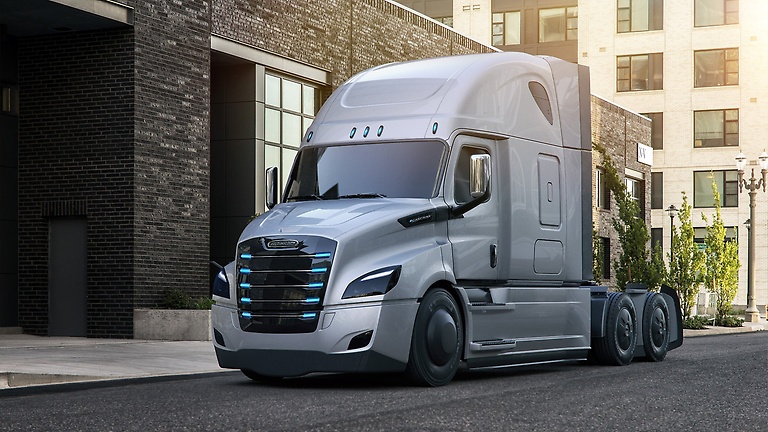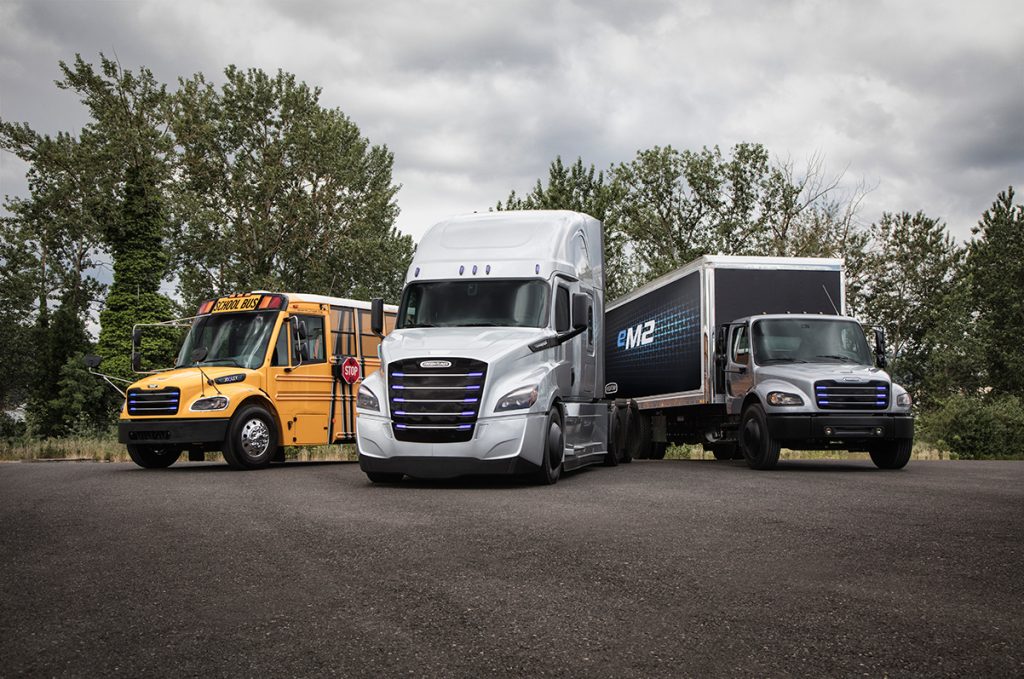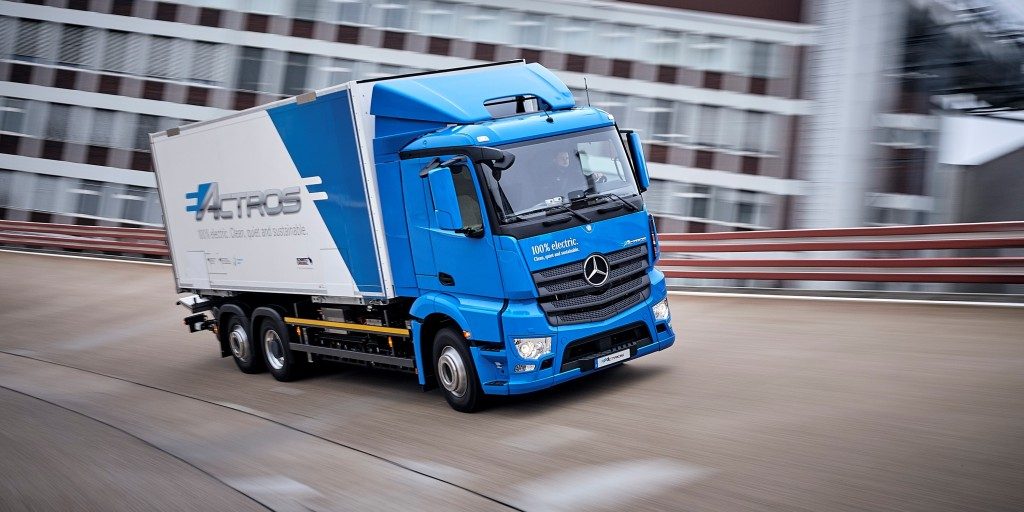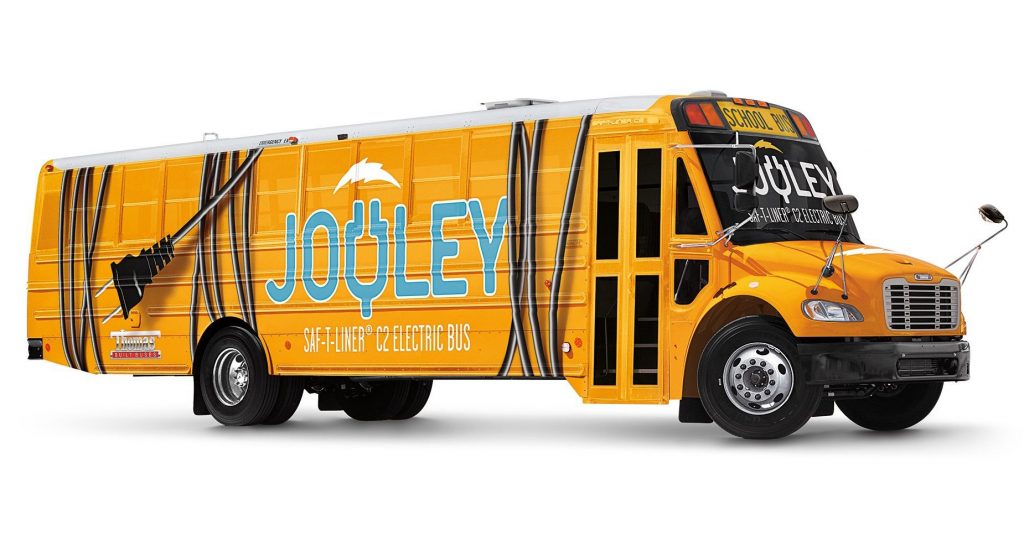Daimler Unveiling Electric Trucks
PORTLAND, Ore. – Daimler Trucks North America recently unveiled electric Class 8 and medium-duty trucks, with plans to have a 30-truck “innovation fleet’’ working in selected applications before the end of the year.
“It is our target at Daimler to have the broadest e-truck fleet in North America by 2021,” said Roger Nielsen, president and chief executive, as an electrified version of the Class 8 Cascadia rolled by. An electric version of the eM2 106 medium-duty vehicle quietly followed right after.
“Heavy-duty electric vehicles present the greatest engineering challenges, but they also present the greatest learning opportunities,” he said.
Daimler eCascadia
The eCascadia features up to 730 peak horsepower, with batteries that offer 550 kwh and a range of up to 400 km. Up to 80 percent of the battery power can be renewed in about 90 minutes of charging, offering another 300 km of range, the company said. It’s primarily being designed for port drayage trucks and short-haul applications.

Daimler Trucks North America eCascadia
Enjoying our insights?
Subscribe to our newsletter to keep up with the latest industry trends and developments.
Stay InformedDaimler eM2
For the medium-duty segment, the eM2 offers 480 peak horsepower, drawing on batteries with 325 kwh of capacity and a 375-km range. Recharging of those batteries by 80 percent can be completed in about 60 minutes, offering another 300 km of range. That truck is being designed for local distribution, pickup and delivery, food and beverage applications, and last-mile deliveries.
“It’s easy to find use cases for the eM2 today,” Nielsen said. “We expect high customer demand for this truck when we make it available for series production sometime in the next two to three years.”
The medium-duty eM2 will take advantage of the stop-and-go activity in urban environments, he added, referring to regenerative braking.
The eCascadia has an 80,000-pound gross combination weight rating, while the eM2 comes in at 26,000 pounds, according to company officials.
While high-profile launches for North America, these are not the first electrified trucks to emerge from the Daimler portfolio.
MercedesBenz eActros
The MercedesBenz eActros has a 200-km range and a 55,000-pound gross combination weight rating and is being tested with customers in Europe. The E-Fuso Vision One Class 8 truck being tested in Japan has a range of 350 km and gross combination weight rating of 51,000 pounds. At the smaller end of the scale, the Class 4 Fuso eCanter — unveiled last year in Atlanta, Ga. — is available in series production.
The fully electric Mercedes-Benz Citaro goes into series production in late 2018, while the Mercedes-Benz eActros distribution trucks unveiled earlier this year will be working with the first customers by the second half of this year, the compay said.
Freight not the only avenue
Freight is not the only focus, of course. Thomas Built Buses now has an all-electric Saf-T-Liner C2 Jouley school bus, unveiled in November 2017, which offers a 160-km range and begins limited production in 2019.
Freightliner Custom Chassis Corp., meanwhile, built more than 100 electric vehicles in 2012 with Electric Vehicles International on the MT-55 walk-in van chassis.
The batteries for the newest trucks are shared by the eCetaro and eCascadia, while the battery management systems can be found in the Actros. The goal is to develop a single unified, proprietary electric powertrain for all the vehicles, company officials said.
The announcements come as Daimler unveils a new global E-Mobility Group that will combine the company’s “global scale, global presence, and a strong backbone of support,” said Martin Daum, a member of the Daimler board of management for trucks and buses.
Key Challenges & Milestones
A key challenge that remains, meanwhile, is where electrified vehicles will recharge.
“We are focusing our efforts on quickly advancing that development,” Nielsen said. “We are all in for tackling electrification challenges for North America.’’
Daimler AG is a founding member of the CharIN Charging Interface Initiative, which is looking to develop a standard charging system for battery-powered vehicles. This work is being completed alongside utilities and service providers.
“Without an infrastructure to support and charge these vehicles, there will be no eTrucks on the road,” Nielsen said. “We have the responsibility to give our customers support on the infrastructure side.” For terminals and ports, that means consulting services.
There are other key questions to be answered along the way. “How can we improve the range? … improve the payload? … improve the energy consumption,” Nielsen says. No announcement was made about current payload capacities. “We have much to learn, but we are well on our way.”
Daum describes it as an “evolutionary, not a revolutionary” process.
But expect more electrification rather than hybridization from Daimler.
“I’m not a big fan of hybrid,” Daum said. “For me, a hybrid gives you the worst of both worlds.” Such vehicles still include the challenges of emissions systems for combustion engines and the new technologies needed for electrification. “It’s good for the feeling but not much else.”
“It’s an exciting moment to be here,” Daum said.


























Amazing! We need this trucks on the road as soon as possible. The amount of environmental pollution that regular diesel trucks are producing is unacceptable.